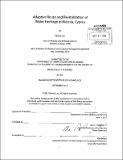| dc.contributor.advisor | James L. Wescoat, Jr. | en_US |
| dc.contributor.author | Lau, Marisa (Marisa May-Lan) | en_US |
| dc.contributor.other | Massachusetts Institute of Technology. Dept. of Urban Studies and Planning. | en_US |
| dc.coverage.spatial | a-cy--- | en_US |
| dc.date.accessioned | 2013-03-13T15:53:22Z | |
| dc.date.available | 2013-03-13T15:53:22Z | |
| dc.date.copyright | 2012 | en_US |
| dc.date.issued | 2012 | en_US |
| dc.identifier.uri | http://hdl.handle.net/1721.1/77837 | |
| dc.description | Thesis (M.C.P.)--Massachusetts Institute of Technology, Dept. of Urban Studies and Planning, 2012. | en_US |
| dc.description | Cataloged from PDF version of thesis. | en_US |
| dc.description | Includes bibliographical references (p. 92-97). | en_US |
| dc.description.abstract | The bi-communal sewerage system developed for the divided capital of Nicosia, Cyprus has been lauded as a rare example of cooperation between the Turkish Cypriot and Greek Cypriot communities. The story of how the project was implemented, and the partnership to operate the system maintained, has been examined many times over in relation to conflict resolution and peace-building in Cyprus. The symbolism attached to the sewerage system as a unifying factor in the divided city contrasts sharply with the way in which the historical water system of the city has been remembered. In this thesis, conservation of Nicosia's water heritage is examined first from a historical standpoint; then as part of the capital's modernization project; and lastly from a planning perspective for the divided city. This research shows that water and waste systems served as one of the few consistent aspects of urban life, as the island changed hands and subsequent rulers of Cyprus imposed their own political, economic and cultural agendas on the capital. Based on this analysis of the historical water system, a conceptual framework that integrates conservation with a broader urban agenda for Nicosia is proposed. Conserved as a socio-technological network, remnants of the water system can be adaptively reused to increase water security at the municipal level. This conservation approach would revitalize the historical water system by leveraging its socio-cultural significance in order to address contemporary planning challenges. | en_US |
| dc.description.statementofresponsibility | by Marisa Lau. | en_US |
| dc.format.extent | 97 p. | en_US |
| dc.language.iso | eng | en_US |
| dc.publisher | Massachusetts Institute of Technology | en_US |
| dc.rights | M.I.T. theses are protected by
copyright. They may be viewed from this source for any purpose, but
reproduction or distribution in any format is prohibited without written
permission. See provided URL for inquiries about permission. | en_US |
| dc.rights.uri | http://dspace.mit.edu/handle/1721.1/7582 | en_US |
| dc.subject | Urban Studies and Planning. | en_US |
| dc.title | Adaptive reuse and revitalization of water heritage in Nicosia, Cyprus | en_US |
| dc.type | Thesis | en_US |
| dc.description.degree | M.C.P. | en_US |
| dc.contributor.department | Massachusetts Institute of Technology. Department of Urban Studies and Planning | |
| dc.identifier.oclc | 828677334 | en_US |
